The morning I picked up the Bisley, my wife and I got to the gun store about 20 minutes before business hours. Even so, there was already another person ahead of us, waiting. Gun owners are persistent and committed. As if to make us prove the point, the store opened 10 minutes late.
I’ve been exchanging e-mail with a fellow shooter from France, and I remain amazed at the patience and determination people can exhibit when it comes to gun ownership. 10 days seems like forever in the U.S., I can’t imagine what it would be like to wait for months for a routine purchase, or to have ammo rationed, as is the case in France.
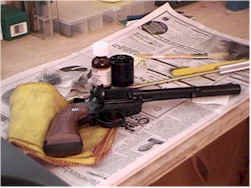 While I filled out the last of my paperwork, the customer who was ahead of us took possession of a Model 629 that had gone through the Smith & Wesson Performance Center. Nice gun; 8 3/8″ barrel, muzzle brake, some pretty fancy grips, and an aluminum case with a big honkin’ S&W medallion. He bought a box of ammo and headed for the indoor range, I picked up the Ruger and headed home to clean it. I may be a little compulsive.
While I filled out the last of my paperwork, the customer who was ahead of us took possession of a Model 629 that had gone through the Smith & Wesson Performance Center. Nice gun; 8 3/8″ barrel, muzzle brake, some pretty fancy grips, and an aluminum case with a big honkin’ S&W medallion. He bought a box of ammo and headed for the indoor range, I picked up the Ruger and headed home to clean it. I may be a little compulsive.
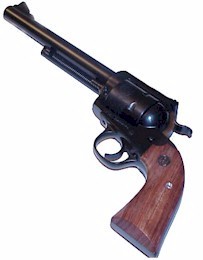 The Bisley has nice lines and good proportion for a gun with a 7.5″ barrel. It does not feel significantly muzzle heavy, in fact, compared to the wide stagger round grips on an autoloader, the Ruger feels compact.
The Bisley has nice lines and good proportion for a gun with a 7.5″ barrel. It does not feel significantly muzzle heavy, in fact, compared to the wide stagger round grips on an autoloader, the Ruger feels compact.
I don’t know if the gun I received is typical of factory output or not. Ruger makes very reasonably priced firearm, but I don’t think that should show up as a general lack of quality in assembly. One grip was misaligned, there was a long thin scratch along the joint of the grip and backstrap, and a small blemish in the barrel bluing midway up the ejector rod housing.
I know guns get marked up in use, but I’d rather do it myself. All that said, most people would probably not be concerned with these small tick marks, but I found it irritating. Functionally the gun is fine, everything rotates smoothly and locks up tightly when it’s suppose to.
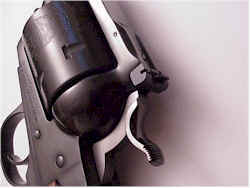 It took quite a bit of scrubbing to get rid of
It took quite a bit of scrubbing to get rid of  preservative coatings, inside and out. I even managed to get some residual machine shop chips out from around the cylinder. But it cleaned up really nicely and the session concluded with a pile of filthy patches and a lightly oiled version of the gun I thought I had purchased.
preservative coatings, inside and out. I even managed to get some residual machine shop chips out from around the cylinder. But it cleaned up really nicely and the session concluded with a pile of filthy patches and a lightly oiled version of the gun I thought I had purchased.
The light scroll engraving on the cylinder is a nice touch, the finish (other than noted) is an even satin. The sights are clean and solid, adjustment is positive, and the hammer position at a low angle is easy to cock without shifting grip. As a person who shoots auto pistols almost exclusively, the Ruger took some getting use to.
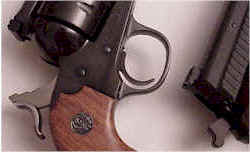 Some of the differences were obvious. I kept waiting to feel the force of the slide coming back against the web of my hand. Twice I began to stoop to pick up non-existent empties from the floor of the range.
Some of the differences were obvious. I kept waiting to feel the force of the slide coming back against the web of my hand. Twice I began to stoop to pick up non-existent empties from the floor of the range.
At 3.5 lbs. the trigger pull is short and clean, but that hammer seems to start falling in another time zone, and makes contact in what seems likes minutes after it’s released. The SIG on the right has a hammer travel of about .800″, while the Ruger is more than 1.5″. I don’t know the comparative weight of the parts, but the Ruger appears to have much greater mass. It seems the greatest difficulty I experienced when shooting the Ruger, was squeezing through the trigger release, and follow on concentration on the target.
I finally stopped my autoloader tendencies and next had to get past my double action revolver habits (i.e. no matter how hard I pushed on the cylinder to swing it out for loading – it wasn’t going to happen, and dumping empties was going to be a one-at-a-time proposition.)
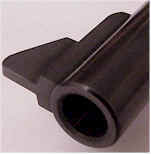 This is my first experience with the .45 Long Colt cartridge. A look at the muzzle seemed to indicate there was a potential for substantial recoil. “Contender/Ruger only” load data I had prepared for use in a week or two, seemed to confirm this suspicion. I was wrong, at least for factory loads.
This is my first experience with the .45 Long Colt cartridge. A look at the muzzle seemed to indicate there was a potential for substantial recoil. “Contender/Ruger only” load data I had prepared for use in a week or two, seemed to confirm this suspicion. I was wrong, at least for factory loads.
I didn’t want to shoot cast bullets or light jacketed target loads for break in, so I picked up a couple of boxes of Winchester 225 grain Silvertips.
 The published velocity for this round is 920 fps out of a 5.5″ barrel. Not sure what the Ruger’s additional 2″ of barrel would add and I didn’t set up teh chronograph this time ti check. The 225 grain Silvertips are the equivalent of a modest handload, over 50% below the heavier end of the performance spectrum.
The published velocity for this round is 920 fps out of a 5.5″ barrel. Not sure what the Ruger’s additional 2″ of barrel would add and I didn’t set up teh chronograph this time ti check. The 225 grain Silvertips are the equivalent of a modest handload, over 50% below the heavier end of the performance spectrum.
The recoil was very light and I’m sure this was helped along with the gun’s hefty weight of 3 lbs. I fired a total of 30 rounds, 6 – 5 shot groups. The first was around 8″, the last about 4″. There were three shot clusters that were no more than an inch, but I had a difficult time consistently holding on target.
My wife, Diane, typically practices at the indoor range with a .22 auto. She can shoot any of the guns we own with a high level of competency, but she goes through a lot of ammo at a practice session, and doesn’t want the distraction of heavy recoil. She had never fired a single action revolver before, but she liked the looks of the new gun and wanted to try it out.
 I loaded two rounds in the gun, walked her through the procedure for shooting a single action, and she put both shots in an area the size of quarter. She reloaded, filling the six chambered cylinder and shot this group.
I loaded two rounds in the gun, walked her through the procedure for shooting a single action, and she put both shots in an area the size of quarter. She reloaded, filling the six chambered cylinder and shot this group.
She felt the longer sight radius helped her to stay on target, and the grips were small enough for her to get a comfortable two hand hold. The recoil was negligible, and I knew I would need to handload a lot more ammo than I anticipated.
This week I’ll get some more range time in, try some other factory ammo and get set up to load this cartridge. I’m not sure what the ultimate use for this gun will be. It clearly isn’t a personal defense weapon. It would be a shame to waste it on punching holes in paper. Maybe it will be dedicated to handgun hunting.
| More “Ruger Bisley .45 Long Colt”: |
| Ruger Bisley .45 Long Colt |
| Ruger Bisley .45 Long Colt Part II |
| Ruger Bisley .45 Long Colt Part III |
| Ruger Bisley .45 Long Colt Part IV |
| Handload Data |

Email Notification